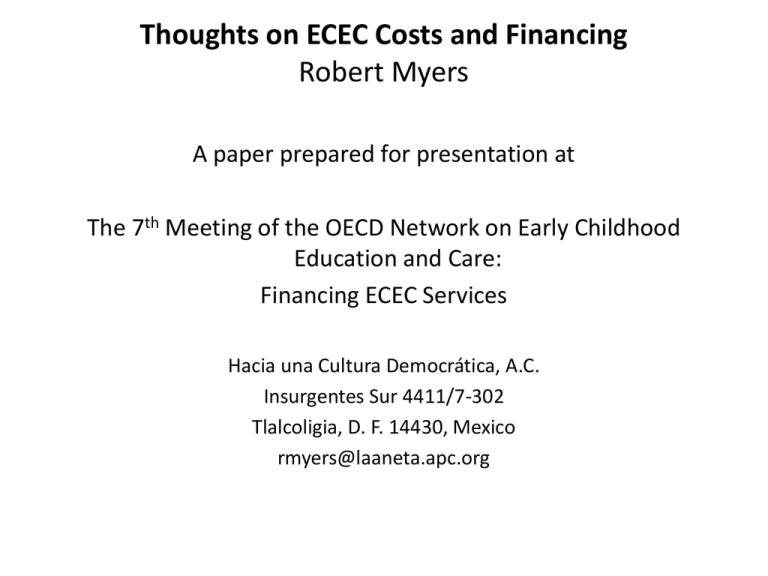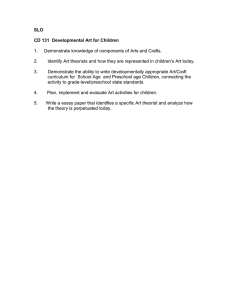Thoughts on ECEC Costs and Financing Robert Myers
advertisement

Thoughts on ECEC Costs and Financing Robert Myers A paper prepared for presentation at The 7th Meeting of the OECD Network on Early Childhood Education and Care: Financing ECEC Services Hacia una Cultura Democrática, A.C. Insurgentes Sur 4411/7-302 Tlalcoligia, D. F. 14430, Mexico rmyers@laaneta.apc.org Organization of the Presentation 1. Mapping financing mechanisms and funding strategies, with an emphasis on Mexico 2. Constructing costs for individual preschool centers, an experimental study in Mexico 3. Conclusions A reminder: care and education at home • Most of the costs of ECEC will be borne by families whose members take their time to provide direct care and educational activities and provide the home conditions settings within which they will occur and/or who contract individuals to be in their home to do so rather than to look to services or programs outside the home. • Therefore the discussion should include strategies to help families bear costs at home. • There is little systematic information about the quality of such care Mexico: ECEC through services and programs Wide variation exists: - size; - the populations served (children of different ages, parents, targeted groups vs. universal availability); - administrative responsibility (educacion, health, welfare, social services, others/ central government, states and municipalities; - location in homes or schools or elsewhere; - infrastructure (degrees of sophistication and maintenance); - teacher or caregiver qualifications and experience; - supervision; - involvement of parents and community; Wide variation (continued) - models taken as the base for action (home-based/centerbased/community-based, instructive/constructive, imported/locallydeveloped, etc); - duration attention (during the day and year); - organizational features (number of children per teacher or caregiver); - content (focused on health, education, care, or integral development of children, and - Purposes (reducing poverty, helping women to earn and learn, preparing children for school or life, caring for children with special problems, etc) This diversity makes it difficult, if not impossible, to construct and to interpret general figures that purport to describe what is being spent on ECEC. Preschool Education • Ages: 3 to 5/6 (Note: “schooling” does not begin at age 5 as suggested in Annex A; 5-year olds still in preschool) • Obligatory (from age 3), free of charge,in theory • Short day • Not much attention to care until recently • Private = 15-16% (higher in cities) • Types: General preschool (urban and rural) = 90% Indigenous preschool = 7.5% Community preschools = 2.5% • Enrolment: 5 year olds approaching 100% 4-year olds. About 85% 3-year olds: about 35% Initial Education • • • • 1. 2. 3. • • Age: 43 days to age 4 (overlaps preschool) Not obligatory. Coverage relatively low (under 10%) Two main streams: Center-based and education of parents Center-based. (Social security institutes (IMSS and ISSSTE) (enrolment 350,000??) - Regular and contracted - Only available to formal sector employees; low coverage of demand - Large variation in costs - Mostly care with weaker education Social development “guarderias” largely centers in homes (300,000). Department of Family Development: for informal sector in theory Parental Education: CONAFE (438,000) Low cost /child = US$112 Oportunidades. Conditional cash transfer (5 million families. No early ed.) Financing Strategies • To my knowledge, Mexico does NOT employ the following strategies for funding ECEC services and programs: - Voucher systems - Tax incentives (deductions or credits) for parents - Universal standard subsidies to families for children during the early years - Tax deductions for centers providing attention to young children - Tax deductions to employers for providing on-site child care Financing Strategies (2) Cleveland and Krashinsky categories • • • • • Child-related leaves and associated benefits. IMSS and ISSSTE provide for a leave of absence 6 weeks prior to giving birth and 6 week following birth, with 100% salary and a guarantee that they can return to their job. There is also a provision for women who, with medical approval, need to be absent from their job during their pregnancy and before the 6 week provision kicks in. Medical benefits are provided for the birth. Families are entitled to coverage for clothing for the baby as well as to a six month supply of food. Publicly provided services. These have been described in the previous paragraphs. Supply subsidies to ECEC services. As indicated above, the initial subsidies provided within the Estancias program would seem to fall within this category. Demand-side subsidies for the use of ECEC services. Through the Oportunidades program, parents are provided with cash transfers and access to health and nutrition services. As yet, these subsidies to not apply to early education. Other financing programs. Small grants from a national pawn service are available to certain types of non-governmental organizations that provide ECEC services. An experimental study of preschool costs in Mexico Characteristics of most educational cost studies: • They do not try to estimate total costs • Studies rarely include costs of resources used in educational institutions that are covered by direct payments or through donations of materials or time made by 1) families, communities and 2) others who are not directly responsible for operating the institutions. • Use for used for budgeting and planning and occasionally for cost-effectiveness analysis. Rarely are they used to identify inequities in an educational system. • Costs are rarely related to the quality of the education provided Micro study of costs in 8 preschools (7 rural) Purposes: - to try out a methodology for estimating the total costs of preschool education, their various components and for identifying who bears costs at the level of individual preschool centers. - Examine how total costs as well as the distribution among cost components and the sources of financing vary among schools, same program and across programs. - Iidentify resource and funding inequities related not only to the resources available but also to the way in which different groups are asked to participate in covering costs Methodology Visits to each center to interview, using standard formats, center directors, teachers, parents and others involved in attending to the preschool children as well as to examine center records and to inventory resources. Gather information about cost “ingredients” (salaries and benefits, infrastructure, materials and supplies, food, overhead, transport, uniforms, training, supervision and participation in school committees and special events) as well as about who was covering the cost of each ingredient Results • Distribution: see Table 1 – Salaries and Benefits = 38% of total costs – Food costs = 36% of total – Private contributions greater (54%) than public • Range per student costs:$9,011 to $18,109 (US$850 to US$1,708) • Per student costs by school: See Table 2 - Average for 8 schools = $14,598 pesos (US$1,377) -Higher than SEP annual report 2006-7 = $11,100 (US$1,047) -Lower than OECD est. = $US2,045 These disparate figures suggest how difficult it is to pin down a specific cost estimate and how much the estimates depend on methods and assumptions applied. Suggestive conclusions/hypotheses from the experimental study • It is difficult to “know” what the real and total costs of early education are. • Costs and who bears the costs differ significantly across programs but also within particular program lines (see, for instance the two indigenous schools in Table 2). • “Average” cost calculations hide crucial information about differences that may be as important, or more so, than the average figure offered to the public. • Quality does seem to be related to per student cost (see columns 3 and 5 of Table 2). • Programs for the poor tend to cost les and place a greater relative burden on parents. • The cost of continuous training and of supervision is extremely low. Closing Thoughts 1. One should not attempt direct comparisons of the costs of ECEC across countries, systems or programs. 2. It is important not to combine cost data from programs that are very different in order to arrive at average per child costs. 3. In many countries, the information base is weak and does not easily permit cost calculations. 4. Most cost studies involve calculations based on public budget allocations or expenditures and focus on direct operational costs; most do not include time or in-kind costs borne by families, volunteers and private organizations. Closing thoughts (2) 5. The estimation of costs required to mount a program of “acceptable” quality is a useful exercise for planning or to compare with the actual costs of programs in operation. 6. It is right to be skeptical of any cost estimate made for an early childhood program. 7. More use should be made of costing and financing information to look at questions of social participation and equity.




